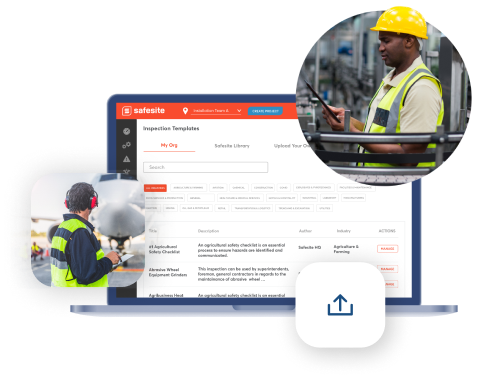Choosing the Right Ladder
Contributor: Safesite Jurisdiction: OSHA
Review the right way to select the correct ladder for the job. Based on OSHA standards, this toolbox talk will help prevent falls from heights and related injuries.

1. OSHA estimates that there are 24,882 injuries and as many as 36 fatalities per year due to falls from stairways and ladders used in construction. Nearly half of these injuries are serious enough to require time off the job--11,570 lost workday injuries and 13,312 non-lost workday injuries occur annually due to falls from stairways and ladders used in construction.
2. Choosing the Right Ladder: Read and follow the manufacturer's instructions posted on the ladder.
3. Choosing the Right Ladder: You must be trained and authorized prior to using ladders.
4. Choosing the Right Ladder: Is the ladder strong enough to support you and the equipment you will be using. Ladder capacity is shown as follows: Light Duty (Type III) 200 pounds maximum.
5. Choosing the Right Ladder: Is the ladder strong enough to support you and the equipment you will be using. Ladder capacity is shown as follows: Medium Duty (Type II) 200-225 pounds.
6. Choosing the Right Ladder: Is the ladder strong enough to support you and the equipment you will be using. Ladder capacity is shown as follows: Heavy Duty (Type I) 225-250 pounds
7. Choosing the Right Ladder: Is the ladder strong enough to support you and the equipment you will be using. Ladder capacity is shown as follows: Extra Heavy Duty (Type 1A) 250-300 pounds
8. Choosing the Right Ladder: Ladder must be long enough to work safely without standing on the top step or strectching beyond a safe distance.
9. Choosing the Right Ladder: Does the ladder have the right feet for the surface on which it will stand.
10. Choosing the Right Ladder: Is ladder in good condition and safe for use. Check for the following: Rungs must be intact and free from grease or oil.
11. Choosing the Right Ladder: Is ladder in good condition and safe for use. Check for the following: Make sure there are no splinters or sharp edges.
12. Choosing the Right Ladder: Is ladder in good condition and safe for use. Check for the following: See that metal ladders are not dented or bent.
13. Choosing the Right Ladder: Is ladder in good condition and safe for use. Check for the following: Make sure the hinge spreader works properly.
14. Choosing the Right Ladder: Is ladder in good condition and safe for use. Check for the following: All support braces and bolts must be secure.
15. Choosing the Right Ladder: Only use ladder in area free from overhead obstruction and power lines.
16. Choosing the Right Ladder: Is ladder in good condition and safe for use. Check for the following:
17. Carrying Ladders: Ladders should be carried horizontally, rather than vertically.
18. Carrying Ladders: Grounds around base of ladder should be free should be free of hazards.
19. Carrying Ladders: If you're carrying a ladder by yourself, make sure you can lift it easily. Use one hand to grasp the rail of the ladder at its midpoint. Carry it horizontally and walk with the front of the ladder slightly higher than the back.
20. Carrying Ladders: Get help, if the ladder is too long or to heavy.
21. Write Comments or Remarks here:
Additional Comments

Can't find what you are looking for?
